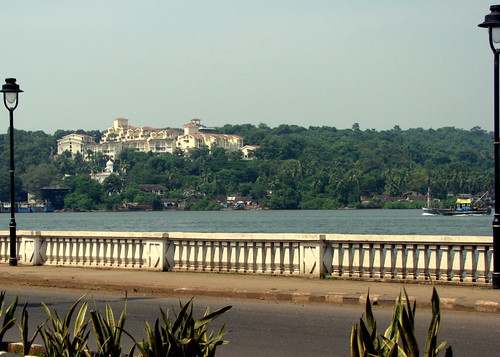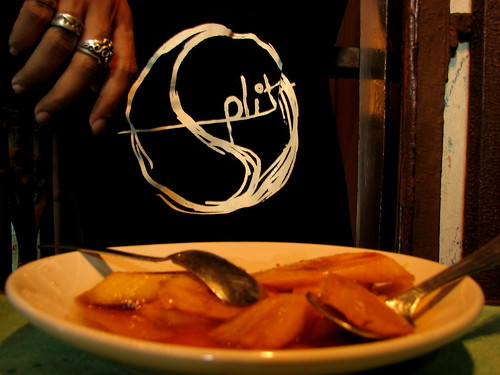And that's how I came to spend a decent portion of my days in Panjim. Before I get to anything else, let me tell you that when discovering Goa, stick to the Outlook guide. Despite its erroneous maps and slightly vague road directions, it's a very well-researched and well-written book with some excellent photos — as opposed to the completely ludicrous Times of India Goa guide. It was also a lot of fun trying to find the places that are supposed to be in one corner of the map but are really some way off! And apart from the places-to-see recommendations, I also discovered a number of interesting dining options through the guide.
It's an interesting thing about the towns of Goa, or at least the ones I saw. Unlike Bombay, Bangalore or Hyderabad, the center of activity is usually not more than a couple of kilometers from the town limits. For example, once you've crossed the Mandovi Bridge and driven into Panjim, the river front and its associated landmarks, restaurants, and precincts are either just there or a very short drive away. It's the same with both Mapusa and Madgaon.
To say that Panjim's really glorious is stating the obvious. The city is enchanting, with its Portuguese architectural heritage and one-way roads, all of which lead into Church Square, the seeming center of town. The river front is like the main road of Panjim and you'll find most of the sights down one left or the other off it. It's a lovely, green-shaded road that is best explored at leisure or you'll miss gorgeous buildings like the the green-yellow-white Secretariat (which is currently under restoration) and the beautifully built and maintained promenade with its parks and restaurants and the Kala Academy.
We turned back only at the sign post for Miramar, the Juhu Beach of Panjim, and randomly followed one of the lanes leading into Church Square. Along the way, little markets grow into blue buildings with contrasting green trees and traffic islands with designer artefacts. You'll also find that the stories you've heard of Goans (in Goa especially) with a strong Portuguese identity aren't the figment of someone's exaggeration. There were a number of stores with signs in Portuguese and NOT in English. The only reason I knew that one of those stores was a fabric store was because the Portuguese word for textile, which I cannot remember right now, is easily recognisable in English.
 One of the main sights in Panjim is Our Lady of Immaculate Conception in Church Square — so named after this church. It's a pretty church with an exquisite altar indeed. But its magnificence was eclipsed completely by the ex-reviewer's Jesus number.
One of the main sights in Panjim is Our Lady of Immaculate Conception in Church Square — so named after this church. It's a pretty church with an exquisite altar indeed. But its magnificence was eclipsed completely by the ex-reviewer's Jesus number.See that little blue pulpit?
Our man decided that he needed to express his atheism for posterity in the land of his roots. So up he climbed to the pulpit and spread his arms wide, like Christ the Reedemer, for the benefit of my camera! He also proceeded to bless an imaginary congregation! Amused as I was, I've also rarely been as scared as I was taking those photos. In a known city, you know what is permissible and not. For all I knew, in Panjim, we could well have gotten lynched for a stunt like that.
Just to the right of Our Lady of Immaculate Conception is this incredible little place called George's Bar and Restaurant. It's obviously a local favourite because most of the patrons were locals. George's is where I discovered the joys of the perch, the butter fish, and the Goan sausage pulav — they've got to serve the best Goan sausage ever! I must admit that I did not like the feni much but with no choice — since they don't serve King's — it will do. The service is also excellent — ask for a guy called Santosh.
When you stand on the steps of the church with your back to it, you'll see two left turns, one far and the other nearer. The far left takes you up the gentle slopes of Altinho, pronounced Aal-teenyu according to the guidebook. Altinho seemed to me the Altamount Road of Panjim, consisting mainly of mansions and winding, airy roads lined with trees that have been around since Adam. The area looks like old money, complete with the Bishop's Palace (it really is a palace!) and dramatic views of the water ways surrounding the city.
In a strange city, I've often found that going down one lane through another, being utterly lost, takes me where I want to be. As it was with our way into Fontinhas, the Latin heritage quarter. Let me say this now before I repeat myself endlessly — I love, love, love Fontinhas. For one absolutely wonderful moment, I thought I was back in Jew Town in Kerala. But as the shutter fell and I explored the area further, the Goan flavour of Fontinhas was unmistakable. I strongly recommend that you walk around the area for hours, getting to know its dilapidated yellow, red, blue, green, dark pink houses with wonderful blue ceramic name plates.
Fontinhas done and it was nearly sunset. While waiting for it to be dinnertime, we killed time taking a cruise on the Mandovi. I thought I'd rant about my terribly bad experience but I'll suffice it to warn you that you should avoid the ones on the river front. We didn't have the time to explore more peaceful options (if any) but I wish we'd stayed away from the Santa Monica sundown cruises. Also, it might also be a good idea to go on a morning cruise since one would actually be able to see something then!
We'd decided we'd end the day with a meal at the Hotel Venite, a place that the guidebook describes as having shut down the residential area to use the rooms to expand the bar! But don't you know, the bloody thing wasn't on the harebrained Panjim map. We found it by sheer serendipity while looking for a way back to Church Square. It was the magnificent seashell and blue mosaic doorway that first drew my eye and the friendly, cheery waiter in the balcony, who directed us back and helped ensure that I wanted to come back.
I can't tell you how glad I am that we did. The Hotel Venite was possibly amongst the best restaurant experiences I've ever had. Once you cross the seashell threshold, a warm warli mural covers walls that enclose a brown-red and cream staircase leading up to the sitting area. What I had presumed were merely decorative balconies were actually booths with a really small table and two stools each, lit by a madly swinging cane lantern — look at the far end of the photo below. I have some excellent night shots of that evening despite not having a tripod. In fact, if that evening has taught me something, it's that I should always, but always, carry my tripod, because at the Hotel Venite, I might need it during the day as well.
It's been well over a month since I've been back and I still do not have the words to describe the sensory assault of a wonderful day followed by a cool, still night, encased in warm, liquid yellow light, mingled with fantastic feni, good food, and excellent service. If you finish up with rum caramel bananas, then life ceases to be elsewhere indeed. I hope this photo shows you what I mean, though.
Finally, should you be a North Goa person, I'd strongly recommend not missing out on Panjim. It's a Goa you won't see in a shack, restaurant, or club at the beach: there's an everyday-ness about Panjim that puts you at your ease almost at once. There is also a sense of sudden surprise that lurks in every corner, which will make you want to ride and walk around all day. That's what makes it so interesting and such fun, I think.




7 comments:
Go well, lady. The road is not long but there're many turns in it to keep you interested.
Ask me, I should know.
A fascinating read.
Found this article while browsing through the "Goa Group" on Flickr.
I am a Goan myself (though living in Kuwait for the past 15 years). Your article reminded me of the fond memories that is Panjim. I worked there for 5 years and used to know the place like the back of my hand. Back then, there were no one-way streets. It was all a mad jumble of traffic jam.
ahem...ahem...
what's this about believing goans who say that there might be some portuguese blood in them?
thought that was hogwash!!! oh no, wait a moment...that was just the D^&*%ya clan doubting historical threads ;0) (evil bratty grin)
Alternate career : Travel Writer.
:-)
hey babe ... u should be charing Goan tourism for doing such a wonderful one month feature on your blog.
BTW i'm in your town ... mail me your no.
@Anil P: Thank you very much... I hope you do the same in Bombay. :-)
@Cajie: Thanks - Panjim, in my experience, was still a mad jumble of traffic but easy to navigate through anyway!
@B: I knew that would come... Would have been very disappointed if it hadn't! :D
@Saurabh: Thank you only! :-)
@Kajal: Will mail it across asap... was meaning to mail you about some cooking stuff anyway! :-)
I haven't been there. I hadn't even wanted to be there. Skimming through your posts is the next best thing to actually being there. Luscious pictures too. I particularly liked the one with the starfish and them gnarly feet! ;)
Post a Comment